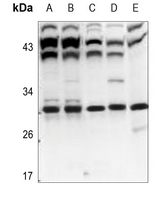Anti-POLR3G Antibody
Rabbit polyclonal antibody to POLR3G
- 产品详情
- 实验流程
- 背景知识
Application
| WB |
|---|---|
| Primary Accession | O15318 |
| Other Accession | Q6NXY9 |
| Reactivity | Human, Mouse, Rat, Monkey |
| Host | Rabbit |
| Clonality | Polyclonal |
| Calculated MW | 25914 Da |
| Gene ID | 10622 |
|---|---|
| Other Names | DNA-directed RNA polymerase III subunit RPC7; RNA polymerase III subunit C7; DNA-directed RNA polymerase III subunit G; RNA polymerase III 32 kDa subunit; RPC32 |
| Target/Specificity | KLH-conjugated synthetic peptide encompassing a sequence within the center region of human POLR3G. The exact sequence is proprietary. |
| Dilution | WB~~WB (1/500 - 1/1000) |
| Format | Liquid in 0.42% Potassium phosphate, 0.87% Sodium chloride, pH 7.3, 30% glycerol, and 0.09% (W/V) sodium azide. |
| Storage | Store at -20 °C.Stable for 12 months from date of receipt |
| Name | POLR3G (HGNC:30075) |
|---|---|
| Function | DNA-dependent RNA polymerase catalyzes the transcription of DNA into RNA using the four ribonucleoside triphosphates as substrates (PubMed:20413673, PubMed:33558764, PubMed:34675218, PubMed:35637192). Specific peripheric component of RNA polymerase III (Pol III) which synthesizes small non-coding RNAs including 5S rRNA, snRNAs, tRNAs and miRNAs from at least 500 distinct genomic loci (PubMed:20154270, PubMed:20413673, PubMed:35637192). Acts as a long tether that bridges POLR3C/RPC3-POLR3F/RPC6-POLR3G/RPC7 heterotrimer and the mobile stalk of Pol III, coordinating the dynamics of Pol III stalk and clamp modules during the transition from apo to elongation state. Pol III exists as two alternative complexes defined by the mutually exclusive incorporation of subunit POLR3G/RPC7alpha or POLR3GL/RPC7beta. POLR3G/RPC7alpha modulates Pol III transcriptome by specifically enhancing the transcription of snaR-A non-coding RNAs. At resting state, occupies the active site of apo Pol III and keeps Pol III in an autoinhibitory mode, preventing non-specific transcription (PubMed:33558764, PubMed:33558766, PubMed:35637192). Pol III plays a key role in sensing and limiting infection by intracellular bacteria and DNA viruses. Acts as a nuclear and cytosolic DNA sensor involved in innate immune response. Can sense non-self dsDNA that serves as template for transcription into dsRNA. The non-self RNA polymerase III transcripts, such as Epstein-Barr virus-encoded RNAs (EBERs), induce type I interferon and NF-kappa-B through the RIG-I pathway (PubMed:19609254, PubMed:19631370). |
| Cellular Location | Nucleus. Cytoplasm {ECO:0000250|UniProtKB:Q6NXY9}. Note=Excluded from nucleoli (PubMed:21898682). In zygotes and the 2-cell stage embryos, mainly in the cytoplasm. Starts to localize to the nucleus in the 8-16 cell stage embryo and early blastocysts (By similarity) {ECO:0000250|UniProtKB:Q6NXY9, ECO:0000269|PubMed:21898682} |
| Tissue Location | Barely detectable in differentiated tissues. Expressed in embryonic stem cells and in other dividing cells, such as some tumor cell lines. |
Research Areas
For Research Use Only. Not For Use In Diagnostic Procedures.
Application Protocols
Provided below are standard protocols that you may find useful for product applications.
BACKGROUND
KLH-conjugated synthetic peptide encompassing a sequence within the center region of human POLR3G. The exact sequence is proprietary.
终于等到您。ABCEPTA(百远生物)抗体产品。
点击下方“我要评价 ”按钮提交您的反馈信息,您的反馈和评价是我们最宝贵的财富之一,
我们将在1-3个工作日内处理您的反馈信息。
如有疑问,联系:0512-88856768 tech-china@abcepta.com.
¥ 1,500.00
Cat# AP60201























 癌症的基本特征包括细胞增殖、血管生成、迁移、凋亡逃避机制和细胞永生等。找到癌症发生过程中这些通路的关键标记物和对应的抗体用于检测至关重要。
癌症的基本特征包括细胞增殖、血管生成、迁移、凋亡逃避机制和细胞永生等。找到癌症发生过程中这些通路的关键标记物和对应的抗体用于检测至关重要。 为您推荐一个泛素化位点预测神器——泛素化分析工具,可以为您的蛋白的泛素化位点作出预测和评分。
为您推荐一个泛素化位点预测神器——泛素化分析工具,可以为您的蛋白的泛素化位点作出预测和评分。 细胞自噬受体图形绘图工具为你的蛋白的细胞受体结合位点作出预测和评分,识别结合到自噬通路中的蛋白是非常重要的,便于让我们理解自噬在正常生理、病理过程中的作用,如发育、细胞分化、神经退化性疾病、压力条件下、感染和癌症。
细胞自噬受体图形绘图工具为你的蛋白的细胞受体结合位点作出预测和评分,识别结合到自噬通路中的蛋白是非常重要的,便于让我们理解自噬在正常生理、病理过程中的作用,如发育、细胞分化、神经退化性疾病、压力条件下、感染和癌症。






